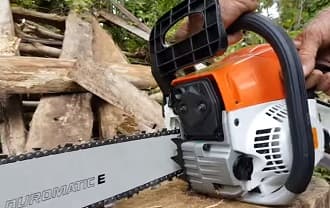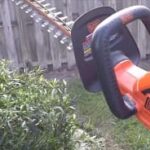As an Amazon Associate, this site earns commissions from qualifying purchases. For more information click here.
If your chainsaw does not spark, it means there is an issue with the engine. Now engines have a lot of parts and figuring out which is the culprit can be daunting. This guide reveals the most likely reasons why you do not see a spark and how to fix it. As you will see, troubleshooting is straightforward.
A problem with the ignition system is the most likely reason why a chainsaw has no spark. The solution is to replace the spark plug or the ignition coil. If that does not work, replace the wires and clean the carburetor.
The ignition system is responsible for igniting the air fuel mixture. Without a spark there will not be any combustion. This will cause the engine to stall. Fortunately there is a way to test this and repair it.
First, wear chaps, gloves, eye protection, steel toe boots and protective clothing. Perform the test and troubleshooting outdoors. Follow all safety guidelines when dealing with chainsaw fuel and voltage.
How to Fix a Chainsaw That Has No Spark
Step 1
Turn your chainsaw off. Check your manual to find the spark plug. In most Proyama chainsaws it is below the chain brake handle on the engine.
Remove the engine cover. You might need a screwdriver here. If you still do not see the spark plug, lift the air filter cover off. The plug will be under it.
Step 2
Use a sock wrench to remove the spark plug. There are tools made specifically for this. You might have to rotate the wrench several times until the spark plug comes off.
When the spark plug is loose, take a good look at it. If there is a crack, the electrodes are worn out or any sign of damage, replace it with a new one. The new spark plug must have the exact specifications as the old one. Check your manual or the manufacturer site for details.
Step 3
Install the new spark plug. The gap has to be the right one for your chainsaw. If the spark plug is not damaged, cleaning might be enough. Use a wire brush to clean and put it back on. Put the air filter cover and the engine cover back on.
Step 4
Switch the ignition on and place the spark plug inside the connector. Look for the chain brake handle on the engine and pull it back. Doing so will disengage it.
Step 5
Hold the park plug and rubber plug about 0.4 to 0.7 inches (1-2 cm) from a metal part on the engine. The metal spot must not have any fuel residue so wipe first if needed.
Pull on the starter cord and watch for a spark on the spark plug. If there is no spark, check the wires and replace any frayed ones.
Why Your Chainsaw Does Not Have Sparks
Knowing how to fix a chainsaw that does not spark is essential, but so is knowing how it happens. The following are the most likely reasons why this happens. Solutions to these problems are also provided here.
Damaged or Dirty Spark Plug
As explained already, a defective spark plug is the most likely culprit. Follow the steps above on how to clean or replace it.
If there is oil on the spark plug, a fuel problem is likely. Inspect the tank and replace the fuel if necessary. You might have to mix oil and gas or store them separately depending whether your chainsaw is a 2-stroke or 4-stroke.
It is good idea to replace the spark plug after every 100 hours of use. While cleaning might prolong its life, do not wait for problems to crop up before replacing it. Chainsaw spark plugs are affordable and replacing it is straightforward. By replacing the plug regularly, problems with the ignition can be avoided.
Damaged Ignition Coil
The ignition coil supplies the spark to the spark plug, which causes the fuel to combust. If the ignition coil is worn out or damaged, the engine will not activate. Because the spark plug and ignition coil are so integrated, you should always check both. The Linkstyle Spark Plug Ignition Tester can find out if these components are working or not.
If your chainsaw does not produce sparks, start with the spark plug. If it is working, check the ignition oil. A damaged ignition coil has to be replaced. Just like the spark plug, the replacement ignition coil must be compatible with your chainsaw.

Clogged Carburetor
The mixing of air and fuel takes place in the carburetor. But if it is clogged with dirt or soot, this will not happen. This usually happens when fuel is left sitting there for months. It turns into a sticky residue and spreads all over the carburetor.
To clean a carburetor:
- Drain the fuel.
- Use a carburetor cannier to remove the oil sludge. Wipe clean.
- Try the engine again. If the carburetor was not damaged the chainsaw should fire up. If it does not, the carburetor might be damaged already.
Carburetor Needs to be Replaced
If cleaning does not work, a replacement may be needed. To find out, pour a teaspoon of fuel in the carburetor. Pull the cord. If the chainsaw starts and stalls, the carburetor is the problem. The only solution is to replace it with one that is compatible with your chainsaw.
This video shows you how to replace a carburetor. If you are not comfortable with DIY, you can take your chainsaw to a service center and have a professional fix it for you.
Faulty On/Off Switch
If the on/off switch is damaged, the engine will not function and the ignition coil will not send a spark. The switch can get worn out with constant use. If it no longer works the system will not function normally.
These switches break down more quickly when exposed to moisture. Dirt buildup as well as accumulated wood splinters, dust, etc. will take its toll on these components. If that is the case, you have to buy a new switch.
Wrong Fuel
Chainsaws will only run with the right type of fuel. Most chainsaws use a 2-stroke engine which requires a mixture of oil and gas. The ratio is typically 50:1 (50 parts gas for 1 part 2-cycle engine oil). Older chainsaws use a 40:1 ratio.
If you make a mistake the engine may not start at all. If the problem gets worse it might not produce a spark either. The solution is to empty the fuel tank and pour a new fuel mixture.
Other Ways to Troubleshoot No Spark Chainsaws
The flywheel magnet and coil must have a gap. For Stihl chainsaws it is .010. Yours might be different so check the owner’s manual. If the gap is correct, remove the ground war from the coil. If it produces sparks, the system is grounding out between the switch and coil.
Disconnect the ground wiring that is linked to the coil. Look for sparks. If there is, the problem has something to do with the chainsaw wiring. You have to check each one to find the damage. While you are inspecting, it is a good idea to examine the on/off switch too. If that is faulty the chainsaw will not run.
If you have ruled out the spark plug and ignition coil, it could be the carburetor. As explained earlier you can clean or replace it, depending on the severity of the clogging. Another option is to add a bit of starter fluid. It could help jump start your chainsaw.
Starter fluid should only be used as a last resort. If it does work, clean the carburetor and try it again but without the fluid. If the engine does not run, the carburetor needs to be replaced.
Check the pistons and cylinders. Most of the time the spark plug or ignition coil are the issues. But it is possible that it is not producing sparks because of the pistons and cylinders. Engines are made up of complex parts that interact with each other. If there is a problem with one, it can affect the others.

I love the outdoors and all the tools for maintaining gardens, yards and lawns. The only thing I am more passionate about is sharing what I know about garden and outdoor equipment.


